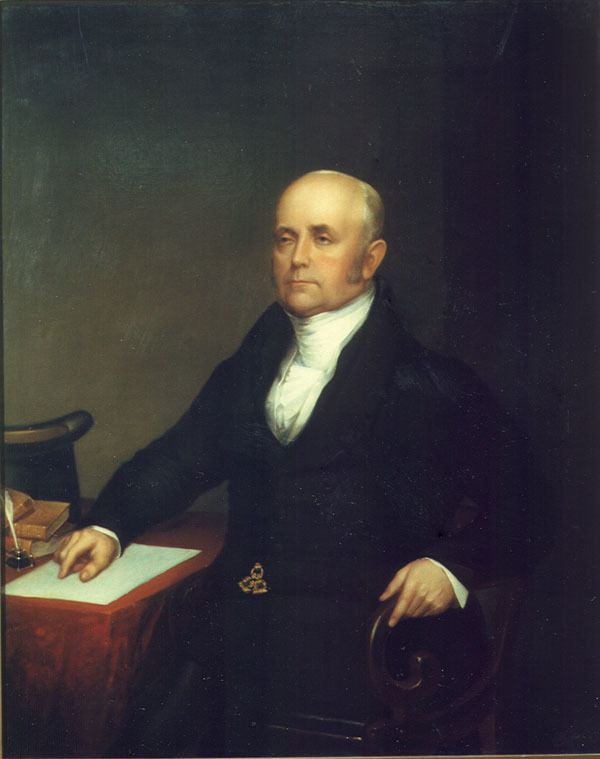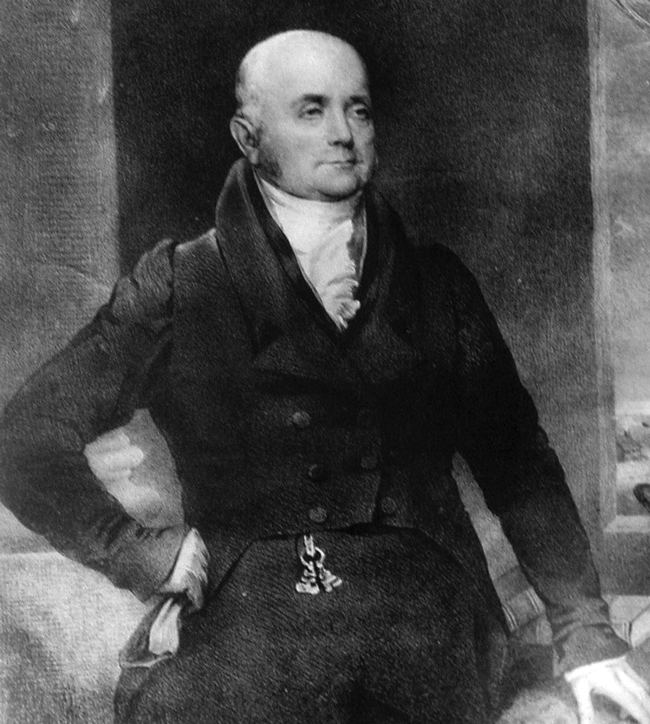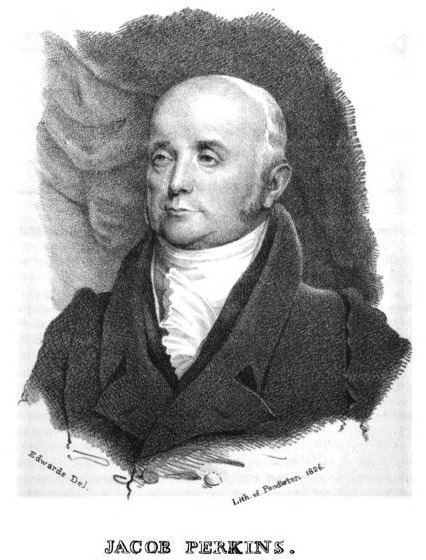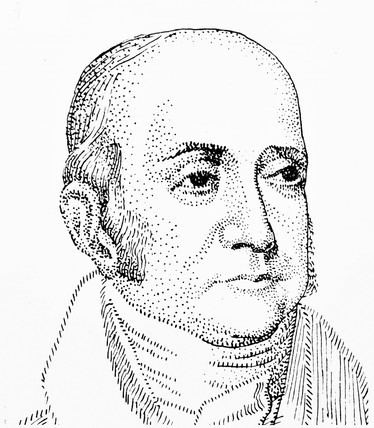Nationality American | Name Jacob Perkins | |
 | ||
Residence United States, United Kingdom Died July 30, 1849, London, United Kingdom | ||
Jacob perkins catcher 2b
Jacob Perkins (9 July 1766 – 30 July 1849) was an American inventor, mechanical engineer and physicist. Born in Newburyport, Massachusetts, Perkins was apprenticed to a goldsmith. He soon made himself known with a variety of useful mechanical inventions and eventually had twenty-one American and nineteen English patents. He is known as the father of the refrigerator. He was elected a Fellow of the American Academy of Arts and Sciences in 1813.
Contents
- Jacob perkins catcher 2b
- The Iceman Cometh Jacob Perkins First Refrigerator
- Early life
- Nail machines
- Cannon boring
- Hydrostatics
- Engraving
- Hermetic tube
- Steam power
- National Gallery of Practical Science
- Refrigeration
- Financial problems detailed
- Patents
- Family
- Death
- References

The Iceman Cometh... Jacob Perkin's First Refrigerator
Early life

Jacob went to school in Newburyport until he was twelve and then was apprenticed to a goldsmith in Newburyport named Davis. Mr. Davis died three years later and the fifteen-year-old Jacob continued the business of making gold beads and added the manufacture of shoe buckles. When he was twenty-one he was employed by the master of the Massachusetts mint to make a die for striking copper pennies bearing an eagle and an Indian.
Nail machines

In 1790, at the age of 24, in Byfield, he created machines for cutting and heading nails. In 1795, he was granted a patent for his improved nail machines and started a nail manufacturing business on the Powwow River in Amesbury, Massachusetts.
Cannon boring

During the War of 1812 he worked on machinery for boring out cannons
Hydrostatics

He worked on water compression and invented a bathometer or piezometer to measure the depth of the sea by its pressure.
Engraving

Perkins created some of the best steel plates (as noted from English Engravers) for engraving, and started a printing business with engraver Gideon Fairman. They began with school books, and also made currency that was not being forged. In 1809 he bought the stereotype technology (prevention of counterfeit bills) from Asa Spencer, and registered the patent, and then employed Asa Spencer. Perkins made several important innovations in printing technology, including new steel engraving plates. Using these plates he made the first known steel engraved USA books (The Running Hand, school books, 8 pages each). He then made currency for a Boston Bank, and later for the National Bank. In 1816 he set up a printing shop and bid on the printing of currency for the Second National Bank in Philadelphia.
His quality American bank currency attracted attention of the Royal Society who were busy addressing the problem of massively forged English notes. In 1819, with his printing business partner, Gideon Fairman, they employed Asa Spencer and went to England at Charles Heath's urging in an attempt to win the £20,000 reward for "unforgable notes". Example notes were shown to the Royal Society president Sir Joseph Banks. They set up shop in England, and spent months on example currency, still on display today. Unfortunately for them, Sir Joseph Banks thought that "unforgable" also implied that the inventor should be English by birth.
Printing English notes ultimately proved a success and was carried out by Perkins in partnership with the English engraver-publisher Charles Heath and his associate Gideon Fairman. Together they formed the partnership Perkins, Fairman and Heath. Heath and Perkins also had support from their brothers. Perkins, Fairman and Heath was later renamed, when his son-in-law, Joshua Butters Bacon, bought out Charles Heath and the company was then known as Perkins, Bacon. Perkins Bacon provided banknotes for many banks, and foreign countries with postage stamps. Stamp production started for the British government in 1840 with the 1d black and the 2d blue postage stamps, which incorporated an anti-forgery measure in the form of a complicated background produced by means of the rose engine. Their stamps were the first known preglued stamps.
Also concurrently, Jacob's brother ran the American printing business, and they made money on important fire safety patents. Charles Heath and Jacob Perkins worked together and independently on some concurrent projects.
Hermetic tube
Jacob Perkins has patents for Heating and Air Conditioning technology. In 1829–30, he went into partnership with his second son Angier March Perkins, manufacturing and installing central heating systems using his hermetic tube principle. He also investigated refrigeration machinery after discovering from his research in heating that liquefied ammonia caused a cooling effect.
Steam power
In 1816, Jacob Perkins had worked on steam power with Oliver Evans in Philadelphia. In 1822 he made an experimental high pressure steam engine working at pressures up to 2,000 psi. This was not practical for the manufacturing technology of the time, though his concepts were revived a century later. Perkins' boiler was the first example of a flash boiler and one of the first examples of a contra-flow heat exchanger. The water-tube boiler consisted of heavy cast iron straight, square-section water-tubes across the firebox, joined by unheated pipes outside it. These tubes were arranged in three layers, with water pumped into the upper layer and steam extracted at the lower, giving that contra-flow arrangement. In 1927, Loftus P. Perkins, a descendant, lectured on these boilers and displayed a 1/8" copper pipe, apparently from a 40 bhp engine of a type that was in use up until 1918.
Perkins' high-pressure steam technology was also used in another invention, the steam gun. This was an early fully automatic machine gun, powered by steam rather than by gunpowder. Although not the first automatic firearm, it was the first to also have a high magazine capacity of more than a handful of rounds. It operated with musket balls at a cyclic firing rate of 1,000 rpm (rounds per minute). It is reported to have been rejected by the Duke of Wellington as 'too destructive'.
In 1827 he became the first person in England to use a uniflow steam engine. A locomotive on the South Eastern Railway was converted to the Uniflow system in 1849, although it is not known whose idea this was.
Perkins applied his Hermetic tube system to steam locomotive boilers and a number of locomotives using this principle were made in 1836 for the London and South Western Railway. This was a very early example of a high pressure steam locomotive.
National Gallery of Practical Science
In 1832 Perkins established the National Gallery of Practical Science on Adelaide Street, West Strand, London. This was devoted to showing modern inventions. A popular feature was his steam gun, which did not find favour with the military.
Refrigeration
Perkins is credited with the first patent for the vapor-compression refrigeration cycle, assigned on August 14, 1835 and titled, "Apparatus and means for producing ice, and in cooling fluids." The idea had come from another American inventor, Oliver Evans, who conceived of the idea in 1805 but never built a refrigerator. The same patent was granted in both Scotland and England separately.
Financial problems detailed
Jacob Perkins and Charles Heath had many business successes, but also had financial difficulties, but usually not at the same time. The accounting records for their printing business shows the two borrowed from the business, and sold shares back and forth when necessary in any and all business ventures, and kept detailed records. This professional relationship ended when Jacob's son-in-law, Joshua Butters Bacon, bought out Charles Heath's share of their shared printing business, which then became Perkins Bacon. At one point he became involved in lawsuits and had to close his engine factory.
Patents
Jacob Perkins has many patents:
Perkins bought some technology, and patented it himself in multiple countries, and employed the true inventors (as was the case with Asa Spencer and Oliver Evans).
Family
Jacob was married on November 11, 1790 to Hannah Greenleaf of Newbury and together they had nine children. His second son, Angier March Perkins (1799–1881), also born at Newburyport, went to England in 1827, and was in partnership with his father (later taking over the business on the latter's death). His grandson, Loftus Perkins (1834–1891), most of whose life was spent in England, experimented with the application to steam engines of steam at very high pressures, constructing in 1880 a yacht, the Anthracite.
Death
He retired in 1843 and died in London on 30 July 1849, at 83 years of age. He was buried in Kensal Green Cemetery, London.
